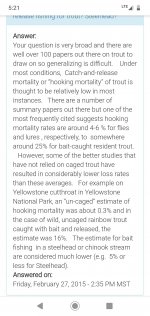I'm surprised no one has challenged the 5% hooking mortality rate that has been mentioned. Doesn't 5% seem too high? I'd guess that probably 90% or more of the angling hours spent on Spring Creek are by fly fishermen. Are you guys saying that you think fly fishing has a hooking mortality rate approaching 5%?
One thing not mentioned is that upgrades at both hatcheries on Spring Creek have pretty much eliminated large trout from escaping. I noticed that the number of big trout (say 15" or larger) in Spring Creek a mile above and a mile below (roughly) the Benner Spring hatchery outlet declined precipitously immediately following the upgrades there. I recall counting as many as 30 - 40 trout of this size in, say, a mile stretch there before the upgrades. Now I am lucky to see more than one or two big trout in a mile stretch (even in the autumn when the trout are visible while spawning). I don't think this is a coincidence.
Another huge change not mentioned is the number of great blue herons (GBH's) that call Spring Creek home for about five months every year (not to mention the year-round residents). I began fishing Spring Creek in 1983 and I'd guess that there were only one or two GBH's living there at that time. I'd guess that there are now maybe fifteen that live there for about five months every year.
A GBH can eat a 15" trout (maybe 1.5 pounds or so of meat), so how many small trout could one GBH eat in a day? My conservative guess is that one GBH could eat ten 4" - 6" trout per day. If one GBH eats 10 trout a day for 150 days, that's 1,500 trout that don't have any chance to become a big trout. Now multiple those 1,500 trout that one GBH eats by fifteen GBH's and that equals 22,500 dead trout. No doubt my estimates are just estimates, but I personally believe GBH's are having a profound effect on the trout population on Spring Creek.
Here's another way to look at the GBH damage: If each GBH ate just one 12" trout per day for 150 days per year that would be 2,250 nice-sized trout gone forever. On a per-stream-mile basis, that would be over 100 nice-sized trout eaten per stream mile -- EVERY YEAR -- and it probably takes about three years for a trout to reach 12" on Spring Creek. Yes, GBH's have a profound effect on Spring Creek.





